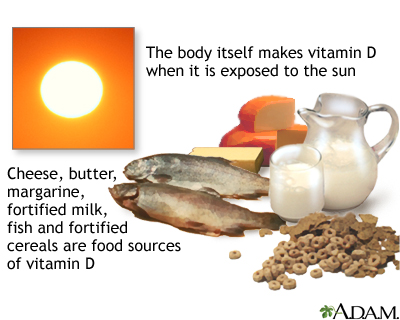Getting enough calcium and vitamin D in your diet can help maintain bone strength and lessen your risk of developing osteoporosis.
Bone Strength and Calcium
Your body needs calcium to keep your bones dense and strong. Low bone density can cause your bones to become brittle and fragile. These weak bones can break more easily, even without an obvious injury.
Vitamin D helps your body absorb calcium. Eat foods that provide the right amounts of calcium, vitamin D, and protein. This kind of diet will give your body the building blocks it needs to make and maintain strong bones.
In addition to getting enough calcium and vitamin D, you can reduce your risk of developing osteoporosis by exercising regularly and avoiding smoking and excessive alcohol use.
How Much Calcium and Vitamin D do I Need?
Amounts of calcium are given in milligrams (mg), and vitamin D is given in international units (IU).
All children ages 9 to 18 should have:
- 1300 mg of calcium daily
- 600 IU of vitamin D daily
All people age 19 to 50 should have:
- 1000 mg of calcium daily
- 400 to 800 IU of vitamin D daily
Adults age 51 and older should have:
- Women: 1200 mg of calcium daily
- Men: 1000 mg of calcium daily
Men and women: 800 to 1000 IU of vitamin D daily. People who are vitamin D deficient or have insufficient amounts of vitamin D will need higher amounts of vitamin D supplementation.
Too much calcium or vitamin D can lead to problems such as an increased risk for kidney stones.
- Total calcium should not exceed 2000 mg per day
- Total vitamin D should not exceed 4000 IU per day

Calcium and Dairy Products
Milk and dairy products are the best sources of calcium. They contain a form of calcium that your body can absorb easily. Choose yogurts, cheeses, and buttermilk.
Adults should choose fat-free (skim) milk or low-fat (2% or 1%) milk, and other lower fat dairy products. Removing some of the fat does not lower the amount of calcium in a dairy product.
- Yogurt, most cheeses, and buttermilk come in fat-free or low-fat versions.
- Vitamin D helps your body use calcium, which is why vitamin D is often added to milk.
If you eat very few or no dairy products, you can find calcium in other foods. It is often added to orange juice, soy milk, tofu, ready-to-eat cereals, and breads. Check the labels on these foods for added calcium.
Other Sources of Calcium
Green leafy vegetables, such as broccoli, collards, kale, mustard greens, turnip greens, and bok choy (Chinese cabbage), are good sources of calcium.
Other good food sources of calcium are:
- Salmon and sardines that are canned with their bones (you can eat these soft bones)
- Almonds, Brazil nuts, sunflower seeds, tahini (sesame paste), and dried beans
- Blackstrap molasses
Other tips to make sure your body can use the calcium in your diet:
- Cook high-calcium vegetables in a small amount of water for the shortest possible time. They will retain more calcium this way.
- Be careful about what you eat with calcium-rich foods. Certain fibers, such as wheat bran and foods with oxalic acid (spinach and rhubarb), can prevent your body from absorbing calcium.
Your health care provider may recommend a calcium or vitamin D supplement for the calcium and vitamin D you need. However, the balance between benefits and harms of these supplements is unclear.
Alternative Names
Osteoporosis - calcium; Osteoporosis - low bone density
References
LeBoff MS, Greenspan SL, Insogna KL, et al. The clinician's guide to prevention and treatment of osteoporosis. Osteoporos Int. 2022;33(10):2049-2102. PMID: 35478046 pubmed.ncbi.nlm.nih.gov/35478046/.
Mason JB, Booth SL. Vitamins, trace minerals, and other micronutrients. In: Goldman L, Cooney KA, eds. Goldman-Cecil Medicine. 27th ed. Philadelphia, PA: Elsevier; 2024:chap 199.
National Institutes of Health,Office of Dietary Supplements website. Calcium: fact sheet for health professionals. ods.od.nih.gov/factsheets/Calcium-HealthProfessional. Updated January 3, 2024. Accessed May 24, 2024.
US Preventive Services Task Force; Grossman DC, Curry SJ, Owens DK, et al. Vitamin D, calcium, or combined supplementation for the primary prevention of fractures in community-dwelling adults: US Preventive Services Task Force recommendation statement. JAMA. 2018;319(15):1592-1599. PMID: 29677309 pubmed.ncbi.nlm.nih.gov/29677309/.
Weber TJ. Osteoporosis. In: Goldman L, Cooney KA, eds. Goldman-Cecil Medicine. 27th ed. Philadelphia, PA: Elsevier; 2024:chap 225.
Test Your Knowledge
Review Date 5/9/2024
Updated by: Neil J. Gonter, MD, Assistant Professor of Medicine, Columbia University, NY and private practice specializing in Rheumatology at Rheumatology Associates of North Jersey, Teaneck, NJ. Review provided by VeriMed Healthcare Network. Also reviewed by David C. Dugdale, MD, Medical Director, Brenda Conaway, Editorial Director, and the A.D.A.M. Editorial team.








